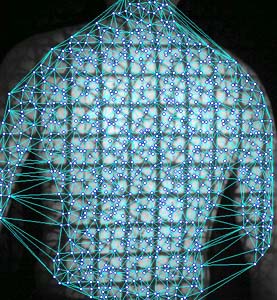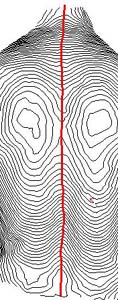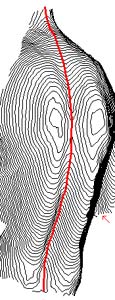 |
| Figure 1. Human back with pattern projected |
This system was developed for a chiropractor to evaluate the patient's spine for scoliosis.
At this stage the system provides accurate information on the curvature of the spine. However, it is not able to determine if the spine is bent abnormally, or if the patient was simply not standing
up straight. A reference frame could be used to overcome this problem.
Pattern projection
A pattern is projected onto the patient's back to aid the image correlation. Image correlation software is trying to find corresponding patches of approximately 10 x 10 pixels in the left and right image. Generally the human skin has very little texture that can be seen in the images. The image correlation then has problem, since there are no (or only very few) distinct features. It can not find matching image patches. Projecting a pattern onto the surface provides many distinct feature for the image correlation to work reliably.
Surface model computation
Two monochrome (black and white) CCD cameras are used to generate stereo images of the patients back. The images can be taken in a fraction of a second. The software then computes a DTM (digital terrain model) over the surface of the patient's back. The resulting 3D point are then exported into ADAM's digital mapping software for the computation of contours. The spine itself is interpreted as the lowest point in the cross-section digitised manually. Software could be developed to produce statistical analysis of the curvature automatically.
 Figure 2. Surface points and DTM display |
 Figure 3. Contour display |
 Figure 4. Contour 55 degrees viewing angle |